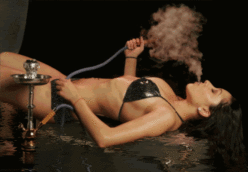More than likely, you’ve seen a hookah in your lifetime. However, unless you’re a regular at a hookah bar, you’ve probably forgotten all about it. Do you still think you’ve never heard of a hookah? Think back. Way back. There you are, lying on your bed, while your Mother is reading the fantastic tale of a little girl in a land of pure imagination. If you guessed Charlie and the Chocolate Factory, you’d be wrong. No, this book was written nearly 100 years before Roald Dahl’s tale of Charlie. The book (and later movie) that gives children their first glimpse of this curious device is Alice in Wonderland. Lewis Carroll, the author of Alice in Wonderland, wrote about an inquisitive, smoking caterpillar. You may remember Sammy Davis, Jr., perched atop a giant mushroom, asking young Alice, “Who … Are … You?” The device the caterpillar was smoking is called a hookah!
Hookahs have been around, in one form or another, for several centuries with their origins generally traced back to what is modern day Turkey. Needing a way to cool the smoke that leaves a tobacco pipe, the Turkish developed a way for the smoke to first pass through water before being inhaled. This cooled the smoke and gave the hookah its trademark bubbling sound.
Modern hookahs have evolved in design but still perform the same, simplistic function as the hookahs of old. The tobacco that is smoked in the hookah has also seen evolution and change. Originally, tobaccos would be mixed with molasses or honey and placed in the bowl-like apparatus atop the hookah. Coals would be directly-applied to this mixture and, instead of burning, the tobacco would be heated to the appropriate temperature to create smoke. Today’s hookah tobacco, commonly referred to as ‘shisha,’ is made with modern components. Tobacco, glycerin and sugar are combined with countless flavors to produce a truly unique smoking experience. The flavors range from fruity apples and oranges to cultural favorites like bubble gum and cola. In fact, there are over 50 flavors available to today’s hookah smokers!
As mentioned before, the tobacco is heated rather than burned. The hookah tobacco is generally void of the chemical additives found in cigarettes. In fact, hookah tobacco is usually composed of only tobacco, glycerin, sugar and flavoring. This is a far cry from the nearly 600 additives that can legally be added to cigarettes. These additives also transform into other chemicals when burned – a process that happens every time a cigarette is lit and smoked.
Cigars, another ‘natural smoke,’ have long been the gourmet smoke among smokers and socialites. They have a “good ol’ boy” reputation that makes it socially unwelcome for women to smoke and are usually found in cigar bars and private clubs. For years, cigars have had no real competition and the hookah stands poised to edge out a serious piece of the gourmet smoking market.
Hookahs come in all sizes, makes and colors. They are crafting of everything from acrylic to crystal, which allows them to traverse the social lines. People can spend anywhere from $20 to $5,000 to find the hookah of their dreams. There are even custom hookah producers who, if you cannot find the hookah you are seeking, will build a hookah that is completely personalized and truly yours.
The cigar bars of yesteryear are finding themselves in direct competition with a new type of business that is sprouting up everywhere. From college towns to bustling metropolises, hookah bars and cafes are becoming the new, trendy place to hang out and smoke. Patrons can rent a hookah (or bring their own) and smoke for anywhere from $7.00 to $20.00 per bowl of tobacco. Each bowl of tobacco can be smoked for nearly an hour, making this an inexpensive alternative to cigars and other smokes.
More than anything, the hookah provides its participants with a wholly-unique, intimate environment that has no boundaries or rules. Everyone is allowed and dreams, thoughts and opinions fly, completely unabated.
Business entrepreneurs are recognizing the curious draw that the hookah has over customers. The investment to open a hookah bar or cafe pails in comparison to the funds required to open a cigar bar. There’s no need for an elaborate humidor and, in fact, one could even get away with just offering hookahs. It’s no wonder that hookah bars are one of the fastest growing concepts among modern day bars and cafes. As simplistic as the hookah’s design, a hookah business is incredibly easy for first-time business owners to own and operate and requires a minimum in upfront capital investments.
So, from a hookah-smoking caterpillar to the day’s newest craze, hookahs have come a long way. Only time will tell if they have a chance against cigars and other gourmet smokes but one thing’s for sure: hookahs are here to stay.

 What Dr. Herman Kattlove, a medical editor at the American Cancer Society, has to say about hookah smoke and its effect on the human body:
What Dr. Herman Kattlove, a medical editor at the American Cancer Society, has to say about hookah smoke and its effect on the human body: